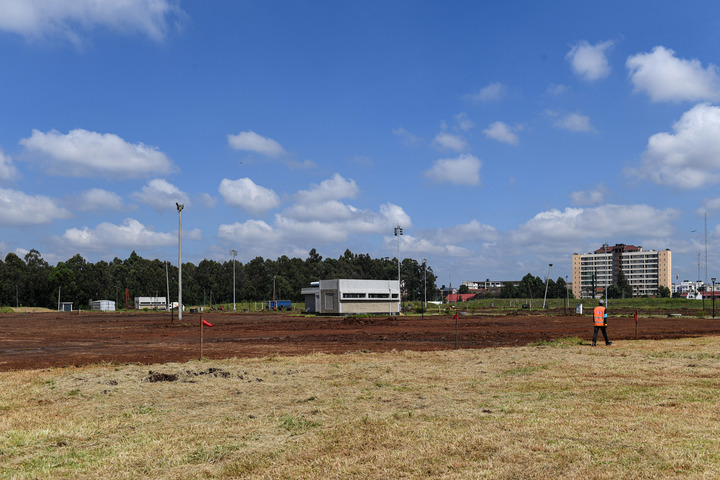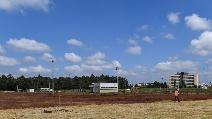The Mombasa-Nairobi Standard Gauge Railway (SGR) has been one of the most notable BRI infrastructure projects in Kenya and in the East African region since its operation commenced in 2017. For the average Kenyans who may not pick interest on the SGR's impact measured by GDP growth among other socio-economic indices, there is a consensus on the fact that the SGR has efficiently transformed Kenya's transport sector, reducing transit time from Mombasa to Nairobi to under five hours for passengers, and eight hours for cargo, which previously took 10 hours and 15 hours respectively, by road.
In 2024, yet another remarkable story unfolds.

This photo taken on March 1, 2024 shows the construction site of the Talanta Sports City, in Nairobi, Kenya. (Xinhua/Li Yahui)
China Road and Bridge Corporation (CRBC), a subsidiary of China Communications Construction Company (CCCC), has already broken ground for the construction of the Talanta Sports City stadium. The tech-savvy facility has been designed to meet the highest international standards. Thanks to advanced technologies such as Video Assistant Referee (VAR) and goal-line technology, the facility will be aptly equipped with top-tier live TV broadcasts to guarantee a world-class sporting experience in the much-awaited 2027 Africa Cup of Nations which Kenya is privileged to co-host with her neighbours, Uganda and Tanzania.
Of importance, sustainable practices are evidenced by aligning the stadium with environmentally consciousness systems such as incorporating renewable energy solutions and merging development with green spaces. This is in alignment with China's effort on building the green Belt and Road which places great importance on green development initiatives that center around environmental sustainability, international standards, and best practices.
The 60,000-capacity stadium is expected to be completed by the end of 2025, a year that marks the start of the final sprint of Kenya's race towards achieving her socio-economic aspirations as outlined in the Vision 2030 Development Plan and the United Nations Sustainable Development Goals.
The Belt and Road Initiative (BRI) cooperation buoys up Kenya's commitment by anchoring sports, art and culture as a pivotal economic engine; creating employment, and catalysing entrepreneurial opportunities for the youth beyond the Africa Cup of Nations in 2027, by curating the best of Kenya's youthful vibrancy through an atmosphere befitting a sporting spectacle, diverse cultural extravaganza, and nonpareil concerts.
China's sustained economic transformation in the last four decades is a testament to the capacity China brings to the global development agenda in terms of knowledge and manpower. In light of achieving common prosperity, the Belt and Road cooperation must advance strategies and alliances to not only achieve BRI's economic and social objectives, but also prioritize emergency response if shared prosperity is to be realized. Come rain, come shine, China has illustrated her capacity to rise to the occasion by implementing mitigating strategies when they are needed most. China presents to the world her lived experience of mobilizing resources to lift about 800 million of her people from poverty, a success that is impossible to ignore as it is historically unprecedented.
Without a doubt, the Belt and Road cooperation represents a new development path and shared prosperity through "people-to-people bonds". In our eyes, the best days of Belt and Road cooperation are still ahead of us.
Editor's Note: This article is written by Esther Oenga from Kenya now enrolled to pursue a Master of Public Administration at the Belt and Road School of Beijing Normal University's Zhuhai campus. The views expressed in this article are those of the author and do not necessarily reflect the positions of Belt and Road Portal.




 A single purchase
A single purchase









